223 Search Results for partner strategies
May 5, 2015
by Carole Zangari -
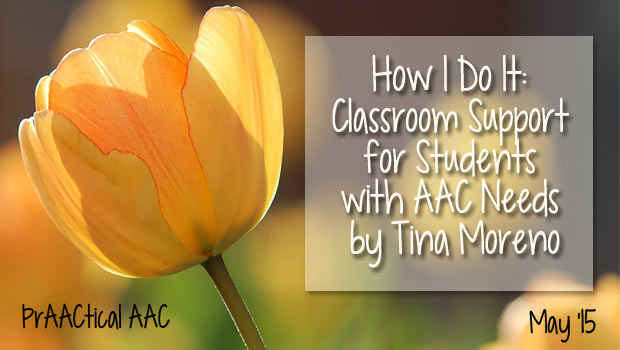
We are fortunate to have a return visit from Tina Moreno, who brings her experiences both as an SLP and also as a mom of a teenager who has used AAC for most of his life. In this post, Tina shares some of the strategies that she has used to support AAC students in their classrooms. If you are a school-based SLP, don’t miss Tina’s classroom observation form for gathering data on how AAC is being used in various activities and lessons. GIVE THEM FIVE As an SLP in the school setting, helping teachers support students in the classroom can be a big challenge. While we can see students making progress in our therapy sessions, it can be difficult to get the same results in the classroom. An important role of the SLP is to collaborate with teachers to help students generalize these skills in conversation with their peers and other... [Read More...]
April 30, 2015
by Carole Zangari -
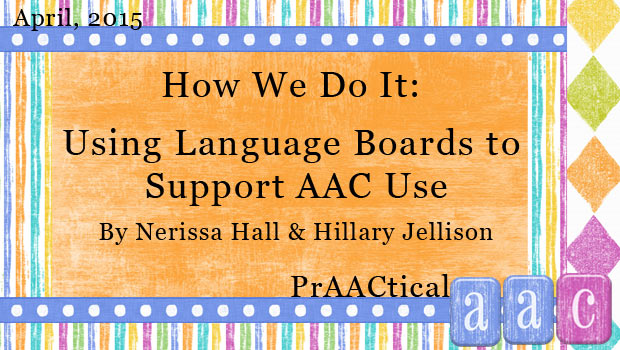
Many of you have reached out to say how much you’ve appreciated the prAACtical suggestions provided by Nerissa Hall and Hillary Jellison, New England-based SLPs and owners of Commūnicāre, LLC. We’re excited to have them back, especially because they are talking about something near and dear to our hearts: Implement a core vocabulary approach in their AAC therapy. In this post, they give us a peek into the ‘why’ and ‘how’ of making and using communication boards that are rich in core words. In their typically generous fashion, they also share templates for the boards that they make. How We Do It: Using Language Boards to Support AAC Use There are a number of different strategies one can use to support an individual’s use of augmentative and alternative communication (AAC). We know that aided language stimulation, augmented input, and AAC modeling are important and effective ways of supporting AAC use. By using... [Read More...]
April 23, 2015
by Carole Zangari -
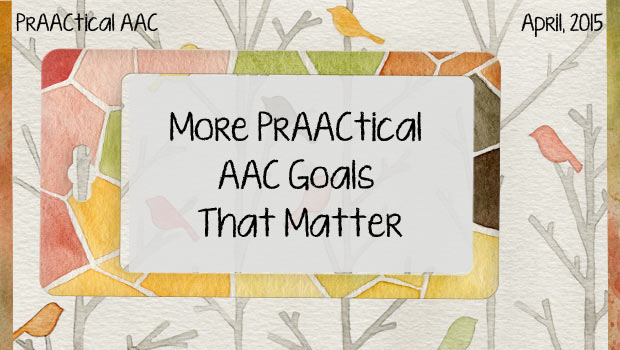
While we may play a variety of roles, a commonality among those of us on teams serving individuals with AAC needs is that we often struggle with developing goals that are meaningful. Let’s work together to develop a list of potential goals that we can reflect on as we work with our clients and their families on a plan for becoming more competent communicators. There are two sections in this post: Qualifiers (for information applying to all goals) and Goal Areas (for actual goals). This is not meant to be a comprehensive list but rather a starting point for a collaborative document. Please join the effort by adding goals in the comment area below or reaching out using our contact form. SECTION 1: QUALIFIERS Each goal can be prefaced with a description of the communicator’s AAC system or the elements of that system can be named. Terms used in this document... [Read More...]
April 21, 2015
by Carole Zangari -
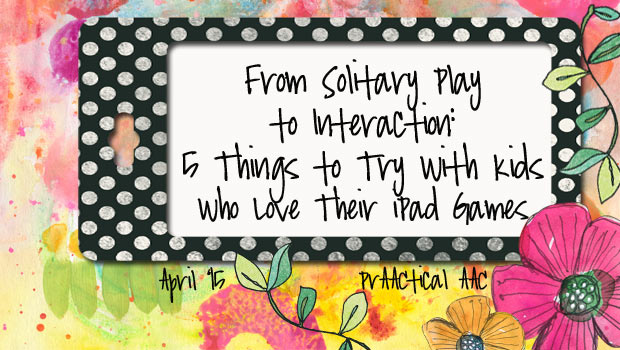
“But my kid wants to use the app on his own terms, not with ME!” Ever faced this conundrum? There are so many wonderful apps that are terrific for building interaction and language skills, but some of our prAACtical friends don’t want us to interact with them during iPad play**. Today, we’re thinking about strategies to use when kids would rather engage in solitary play as opposed to welcoming us as interaction partners in their iPad games. How can we help them increase their tolerance for interaction when playing on the iPad? Here are a few things to try. Make expectations clear with visual supports. It’s hard to cooperate when you don’t have an understanding of what’s supposed to happen. When kids are used to playing games, reading books, or watching videos on their own, they sometimes resist our participation out of the fear that they won’t get to do... [Read More...]
February 12, 2015
by Carole Zangari -
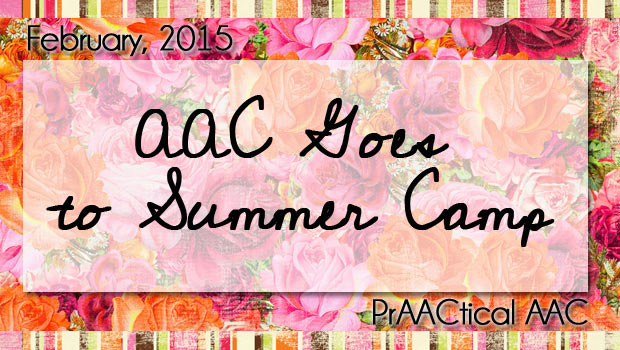
Those of you who are still digging your way out of the most recent snowstorm may not believe it, but it’s almost time to make plans for summer. There are quite a few AAC camps, some that are quite well established and others that have been running for only a few years (see our AAC Camp Pinterest board here). In this post, we hear about one of them from Tina Moreno, an SLP and mom of Mateo, who uses PicturePower 100 on the Maestro to communicate, maintain friendships with his teammates on the cross country team, advocate for himself, reveal his wicked sense of humor, and even sing the National Anthem for his high school’s basketball games. Tina blogs at Voices4All. With the help of Drs. Karen Erickson and David Koppenhaver, she and her friend Gina Cunningham created Camp ALEC together in memory of Gina’s son Alec, who never gave up, and... [Read More...]
February 4, 2015
by Carole Zangari -
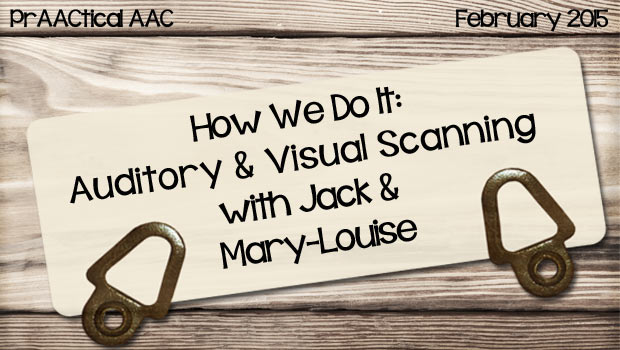
Most of us learn better when we get to see examples of how things are done. In AAC, we don’t have nearly enough examples to learn from so I’m always grateful when someone agrees to show us how they implement particular tools or strategies. Today, we send a big prAACtical “Thank You” to Jack and Mary-Louise in Australia. When children have significant motor limitations, partner-assisted scanning may be their best option for message selection. In this video, Jack and Mary-Louise show us how they use a combination of visual and auditory scanning. Mary-Louise points to choices in his PODD book and says the message aloud so Jack can consider his options. Jack does his part by signaling when he sees/hears a desired message. Because his body is terribly unoccoperative, he signals in a few different ways (i.e., ‘Yes’ with vocalization, eyebrow raises, head nods, &/or eye gaze, and ‘No’ with a... [Read More...]
October 16, 2014
by Carole Zangari -
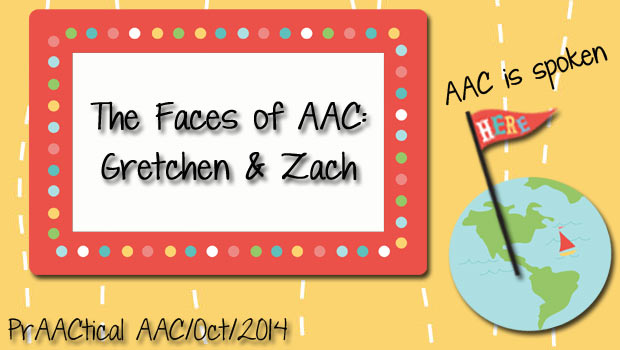
From Bielsko, Poland, to Denver, USA, we are continuing to share the Faces of AAC. Today, we meet SLP Gretchen Storm, who works in the public school system and has a private practice. Gretchen enjoys collaborating with parents, children, teachers, other healthcare providers, siblings and peers in strategies and facilitating communication through speech generating devices. In this post, Gretchen introduces us to Zach. :::::::::::::::::::::::::::::::::::::::::::::::::::::::::: Zach is an 11 year old who uses a Tobii I-12 eye gaze communication device to communicate. He previously used a switch scanning method on a VMax from Dynavox. Zach recently switched to an eye gaze device. Though he loves to use his arms and hands whenever possible, his motor control of them is not ideal for the consistent switch access needed for switch scanning. He was switched to an eye gaze system which could also serve as a switch scanning device if in the future he demonstrates improved... [Read More...]
August 28, 2014
by Carole Zangari -
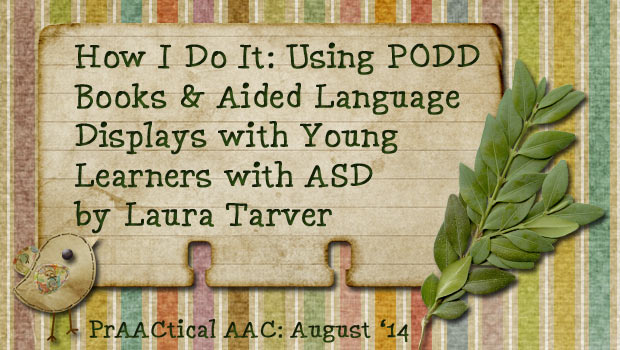
Today, we turn to the UK in a guest post by Laura Tarver. a London-based Speech and Language Therapist working with children with ASD and other complex needs. She previously worked in a primary school for children with ASD, where PODD and Aided Language Displays were introduced as part of a school wide approach in order to enhance the communication-friendly environment for all pupils. In this post, she shares how they used PODD books and aided language input to build the students’ communication skills. :::::::::::::::::::::::::::::::::::::::::::::::::::::::::::::::::: PODD (or Pragmatic Organisation Dynamic Display) communication books were developed in Australia by Gayle Porter, originally for children with cerebral palsy. As their use becomes more widespread throughout the world, practitioners are considering the benefits of using them with other clinical populations. Their structured organisation and emphasis on visual communication means that they are also a valuable tool for developing the communication of those with... [Read More...]
August 5, 2014
by Carole Zangari -
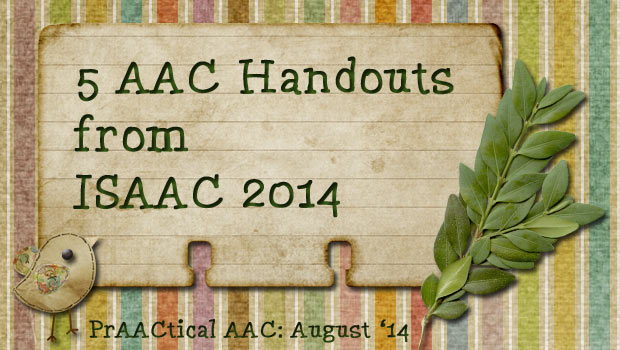
There were so many excellent presentations at the ISAAC 2014 Biennial Conference, it was impossible to get to all of them. Luckily, some of the presenters graciously made their handouts available online. Here are five of our favorites. Getting the Words Out by Deanna Wagner, Caroline Musselwhite, and Martine Smith Communication Partner Instruction for AAC Interactions: A Lifespan Approach by Laura Ball, Cathy Binger, Susan Fager, Joanne Lasker, and Jennifer Kent-Walsh Talking about Emotions Using Culturally Sensitive AAC by Ji Young Na, Sarah Blackstone, and Krista Wilkinson Access is the KEY to AAC: The Role of OT by Susanne Russell and Jennifer Buxton Communicative Competence for Individuals Who Require AAC: Revising the Definition and Strategies by Janice Light and David McNaughton
June 16, 2014
by Carole Zangari -
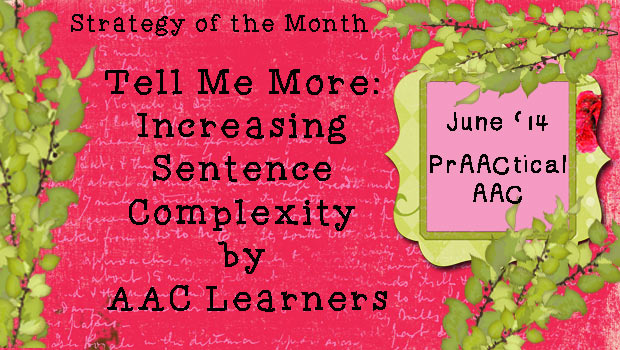
Expanding the length and complexity of sentences is something that SLPs love to work on well beyond the ‘early communicator’ phase, something we talked about a few weeks back. In today’s post, we’ll consider ways to build more complex utterances for learners who are gaining competence with their AAC systems but who still use language that is immature, imprecise, or overly simplistic. In many ways, this therapy is like language therapy for any other learner with delays in grammar, syntax, and morphology. Indeed, we sometimes forget to activate all that we know about language intervention when working learners who use AAC. We try to use that as a starting point and adjust for the AAC components as needed. Here are some of the things that we think about when planning therapy for AAC learners who are trying to strengthen their ability to speak in more complex sentences. Relate the language... [Read More...]









